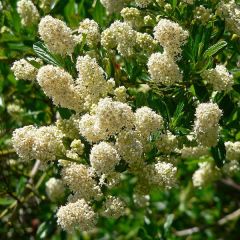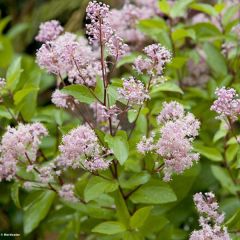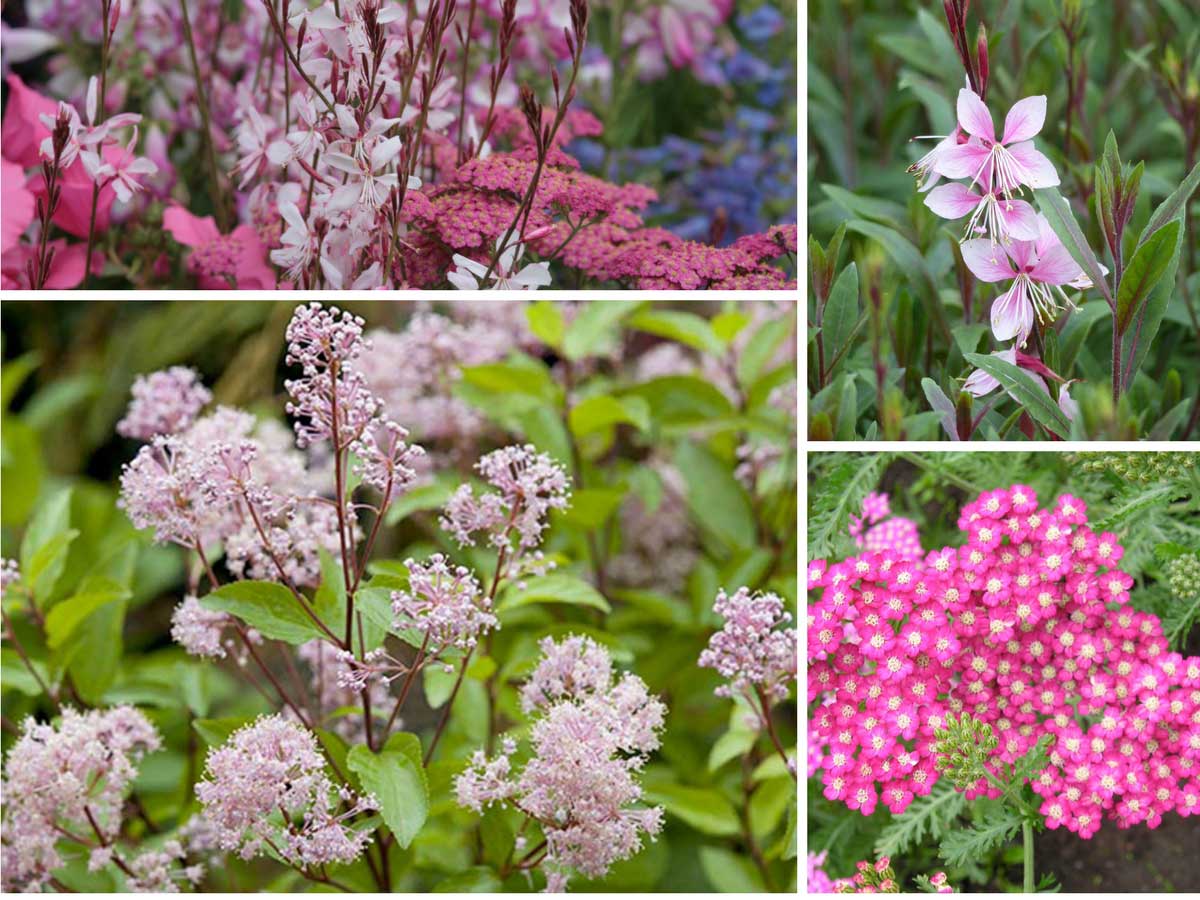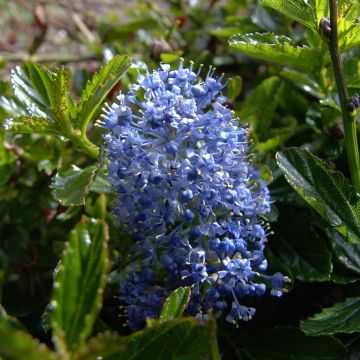
Ceanothus, California lilac: planting, maintenance, pruning
Contents
Ceanothus in a nutshell
- They offer the most beautiful blue flowers in the garden
- Their spring or summer flowering is spectacular
- Deciduous or evergreen, they are easy to grow in hedges, borders, pots, or as specimens
- They thrive in any ordinary soil as long as it is well-drained
- Low-maintenance and resilient, they withstand air pollution
A word from our expert
Ceanothus, sometimes referred to as “California Lilac” due to their delicate fragrance and spikes reminiscent of lilacs, are highly valued shrubs for their abundant spring or summer flowering, which is both melliferous and fragrant. They display their flowering in endless shades of blue.
Intense blue ceanothus, sometimes pink or white, creeping, rounded or upright, evergreen or deciduous ceanothus, California Lilacs offer an incredible variety of forms. Whether it’s the creeping ceanothus Ceanothus thyrsiflorus ‘Repens’, the evergreen ceanothus ‘Skylark’ or the deciduous ceanothus ‘Gloire de Versailles’: all are worthy of being grown for their remarkable ornamental qualities in spring or summer.
Little prone to diseases, with good hardiness (down to -15°C depending on the species), especially in well-drained, light, not overly calcareous soil and in full sun or partial shade, they thrive in all gardens: either as solitary specimens or grouped in free hedges with other shrubs, in romantic pots or sunny rockeries.
Their versatile nature and resistance to pollution make them essential in all naturalistic gardens as well as in urban gardens.
Compact, they form lovely, dense silhouettes with a natural appearance, covered in clusters of flowers.
These generous shrubs, which are truly very easy to grow, deserve a prime spot in your garden or on your terrace. Planting, maintenance, pruning, here are all our tips for successfully growing ceanothus and enjoying a beautiful flowering season.
Botany
Botanical data
- Latin name Ceanothus
- Family Rhamnaceae
- Common name Ceanothus, California Lilac
- Flowering From April to July
- Height 0.45 to 10 m
- Exposure Sun, partial shade
- Soil type Neutral, acidic, well-drained
- Hardiness -10°C to -15°C depending on varieties
The Ceanothus, also known as California Lilac, belongs to the Rhamnaceae family. They comprise around 55 species of deciduous or evergreen shrubs or small trees, native to North America, particularly the coasts and scrub vegetation of California, as well as Mexico. There are nearly a hundred hybrids widely cultivated in our gardens. The most well-known cultivar is Ceanothus coeruleus ‘Gloire de Versailles’. Ceanothus adapt perfectly to our climates.
Within this large family, we distinguish between: evergreen ceanothus that graciously retain their foliage in winter and deciduous species, also known as summer ceanothus.
Evergreen ceanothus flower from spring, from March-April to June, and prefer regions with mild winters and rather maritime climates. While they withstand atmospheric pollution and drought well, they are more sensitive to cold and can freeze in cold regions with humid winters. They are less hardy (they resist down to -7/-10°C, once well established) than deciduous ceanothus like ‘Henri Desfossé’, which thrive throughout France, flower all summer, and are much more resistant to cold (down to -15°C). However, the foliage can sometimes be slightly scorched at -5°C. In mild climates, these species are semi-evergreen.

Ceanothus ‘Gloire de Versailles’ – Photo: Patricia Mario
They exhibit very varied forms depending on the species, ranging from small trees to undershrubs. Their size varies according to the species, from 50 cm for creeping species like Ceanothus prostratus to 8-10 m in height for the largest ceanothus like C. arboreus, which can become true trees. Most remain quite compact, not exceeding about 4 meters in height and width.
Ceanothus spontaneously form a bush composed of multiple stems. The branches are significant, but they consist of small shoots, each bearing numerous leaves, giving them a dense habit. The bushy and flexible habit can be more or less compact or spreading, arched, upright, or prostrate in ground-cover species.
Their growth is moderate to rapid in not too poor soil: they can reach their adult size in five or six years and grow 30 cm per year. Creeping varieties grow quickly, covering slopes and rockeries in just a few years. Evergreen ceanothus with rapid growth have a relatively short lifespan, around fifteen to twenty years.
Whether deciduous or evergreen, ceanothus are particularly floriferous shrubs offering all shades of blue, from pale to indigo. Among evergreen ceanothus, flowering is very abundant. It begins in March-April, later in case of a cold spring (except for Ceanothus ‘Burkwoodii’, which flowers in summer) and lasts about three weeks. Some evergreen varieties offer remontant flowering.
Summer ceanothus provide less spectacular but longer-lasting flowering. The flowers unfold in successive waves throughout the summer from August to October.
In spring or summer, depending on the species, flowers gathered in panicles or upright clusters of 3 to 12 cm long emerge at the tips or along the one-year-old shoots and cover the entire plant with dense and fragrant blue sky, indigo, dark blue, navy blue, bright blue, and more rarely pale pink or cream white bouquets. They appear as floral buds, tightly packed together. They gradually bloom into very small tubular flowers that eventually form beautiful pyramidal inflorescences (or thyrses) so numerous that they almost obscure the foliage. While their fragrance is not strong, it is subtle and reminiscent of lilac, which has earned ceanothus the nickname ‘California Lilac’. Some evergreen varieties are very melliferous and possess a honey-like scent that attracts bees and butterflies. This fragrant flowering is followed by the formation of seeds that are expelled to the ground once mature.
California lilacs are beautiful, bushy, and vigorous shrubs. With relatively rapid growth, they exhibit quite lush foliage. The compact flower spikes overwhelm a beautiful, shiny green foliage of fine texture. They bear deciduous or evergreen leaves, alternate or opposite, finely dentate, with sometimes strongly marked veins, ovate, elliptical, or oblong, generally glossy on top and downy underneath. Ranging from 1 to 10 cm long, they appear in shades from medium green to dark green, including olive green, grey-green, or blue-green with a satin finish. Some, like Ceanothus arboreus ‘Trewithen Blue’, can bear leaves up to 10 cm long. The persistent foliage of ceanothus resists atmospheric pollution.
Ceanothus are easy to grow in ordinary but well-drained soil. However, they do not all have the same requirements. Evergreens prefer rather maritime climates and regions with mild winters. They fear neither heat nor drought. All ceanothus thrive in well-drained, sufficiently rich, light soil, not too calcareous. They tolerate slight acidity and limestone but in small doses. They are content with ordinary soil, even poor, fresh to very dry in summer. They dread heavy, waterlogged soils and winter and summer humidity that can be fatal to them. Reserve a warm spot for them, sheltered from cold drafts, against a sunny wall for the more frost-sensitive evergreens. They only flower well in the sun but tolerate partial shade, especially in southern France. Deciduous ceanothus are more cold-resistant (down to -15°C) than evergreen species (-7/-10°C), especially in well-drained soil.
Ceanothus are versatile in the garden. They can be used in shrub beds as well as in isolation, in borders, in free hedges, or trained against a wall. Creeping varieties are perfect for rockeries, low hedges, or ground cover on large slopes. Deciduous species, which are hardier, thrive equally well in open situations or against a wall. Evergreens settle well in an oceanic or Mediterranean garden, even by the sea. Some varieties are suitable for pot cultivation for your balconies and terraces. They can be combined with plants that will accompany or take over their flowering, such as Fremontodendron californicum, bushy cistus, broom, junipers, cytisus, Chinese almond trees, Japanese quinces, or even Syringa, with clusters of small blue or pink flowers that should bloom simultaneously.
Use them, mixed, in large flowering hedges, alongside remontant bush roses, hydrangeas, deutzias, serviceberries, or buddleias.
Species and main varieties
The genus Ceanothus includes over 50 species as well as around a hundred hybrids and cultivars that are easier to acclimatise, less frost-prone in particular, and of more modest dimensions compared to wild species. The foliage is evergreen or deciduous. Evergreen Ceanothus are not very hardy, prefer mild and humid climates, and are in flower in spring. Deciduous species, which are more hardy, bloom throughout the summer.
The choice is therefore very wide; Ceanothus ‘Gloire de Versailles’ is the hardiest of the deciduous species, ‘Concha’ is a very beautiful compact variety that offers one of the most stunning blues, Ceanothus pallidus ‘Marie Simon’ produces pink flowers at the end of summer, and ‘Italian Skies’ forms a small, regular dome covered with fine foliage.
Ceanothus adopt very diverse forms depending on the species. Some are prostrate and will not exceed 1 m at ripeness, while others have an upright habit like Ceanothus arboreus and are notable for their large size (4 to 8 m high).

Ceanothus exhibit a great diversity of habit
Compact varieties like Ceanothus thyrsiflorus repens, which cascade down, are used as ground cover, in pots, and are excellent on dry slopes.
Choosing a Ceanothus can be guided by size, whether large or creeping, by colour, or by the flowering period, whether early or summer. Discover our favourite Ceanothus for borders, pots, hedges, rockeries, or as ground cover.

Ceanothus arboreus Concha
- Flowering time May, June
- Height at maturity 3 m

Ceanothus thyrsiflorus repens - Californian Lilac
- Flowering time June, July
- Height at maturity 1 m

Ceanothus foliosus Italian Skies
- Flowering time May, June
- Height at maturity 1 m

Ceanothus griseus var. horizontalis Yankee Point
- Flowering time May to July
- Height at maturity 1 m

Ceanothus thyrsiflorus Millerton Point
- Flowering time June to August
- Height at maturity 2 m

Ceanothus delilianus Gloire de Versailles
- Flowering time August to October
- Height at maturity 1,50 m

Ceanothus delilianus Henri Desfossé
- Flowering time September to November
- Height at maturity 1,50 m

Ceanothus pallidus Marie-rose
- Flowering time July to November
- Height at maturity 1,50 m
Discover other Ceanothus
View all →Available in 1 sizes
Available in 0 sizes
Available in 1 sizes
Available in 3 sizes
Available in 3 sizes
Available in 0 sizes
Available in 1 sizes
Available in 1 sizes
Available in 2 sizes
Available in 1 sizes
Planting Ceanothus
Where to Plant
Trellised against a wall, in a mass, as ground cover, or as isolated specimens, ceanothus are suitable for all uses. Compact varieties with a spreading habit of evergreen ceanothus are used as ground cover, in containers, or to cover a sunny slope or pergola.
- The ideal exposure: Give them a spot in full sun or partial shade to ensure they produce the maximum number of flowers.
- Well sheltered: California lilacs appreciate situations protected from the cold. Evergreen ceanothus are sensitive to cold and more frost-prone than deciduous species, and they may be at risk from the harshest winter frosts in northern France. In these regions, reserve a location sheltered from cold winds. Trellis the most frost-sensitive evergreen species against a warm wall.
- The right soil: Indifferent to soil type, they prefer light, neutral soils as long as they are well-drained. Once well established, ceanothus can even tolerate summer drought. They are content with poor, very dry soils in summer. They are easy to grow in well-draining soil and will show more hardiness because they fear excess moisture, heavy, waterlogged soils. When planted in good conditions, evergreens can withstand short frosts down to -12°C. They can therefore tolerate all types of soil, except for very calcareous soils in which they suffer from chlorosis, leading to discoloration and yellowing of the leaves.
When to Plant
Spring is the best time to plant ceanothus. Plant in March-April, at the latest in May, when all risk of frost has passed. Planting in autumn, from September to October, is also possible for deciduous species, especially in mild regions with gentle winters.
How to Plant
Mix deciduous and evergreen species to stagger flowering from spring to the end of summer. Space the plants 2 m to 4 m apart depending on the varieties of ceanothus. In case of soil that retains winter moisture, it is better to plant ceanothus on a mound, as their roots do not tolerate standing water.
In the Ground
- Moisten the root ball by soaking it in a bucket before planting.
- Dig a hole about 40 cm deep, loosen the soil, and remove stones and roots.
- Make a bed of clay balls or gravel 30 cm thick, then spread a layer of well-decomposed compost at the bottom of the hole.
- Place the root ball on the soil, with the collar level with the ground, and backfill the planting hole with the extracted garden soil mixed with good potting soil in equal parts.
- Firm the soil around the base of the bush to form a basin and water thoroughly.
- Water once a week during dry weather to encourage recovery; afterwards, it will be unnecessary and even inadvisable to water.
Trellised Against a Wall
- Attach the shoots as they grow.
- Encourage lateral branches by removing the others.
How to Plant Ceanothus in a Pot?
Ceanothus of modest size make a statement in a large pot on the terrace, to be stored in very cold regions.
- Prefer compact varieties (‘Italian skies’, Ceanothus thyrsiflorus repens)
- Choose a container large enough for the bush to develop well (minimum height of 65 cm)
- At the bottom of the planting hole, ensure perfect drainage with clay balls or pumice.
- Plant the ceanothus in a mixture of sandy soil and good potting soil.
- Choose a location in full sun or partial shade in southern regions, well sheltered from cold winds that may scorch the foliage.
- Water regularly twice a week in summer and very little in winter.
- Repot every two years into a larger container.
→ Learn more in our advice sheet: Growing Ceanothus in a Pot
How to prune a Ceanothus and care for it properly
Hardy sometimes down to -15°C, depending on the species, resistant to drought as well as atmospheric pollution, Ceanothus are of unmatched robustness. They require no specific maintenance and are the perfect companions for gardens without gardeners!
Aside from the first two summers following planting, it is unnecessary and even inadvisable to water Ceanothus in the ground. Just add compost to promote growth.
Container-grown specimens, on the other hand, need more attention than their in-ground companions: liquid fertiliser for roses added to the watering can to encourage flowering and regular watering, especially in summer.
Ceanothus do not require any special pruning; simply cut back dead branches or those that disrupt the bush’s habit after flowering. During summer, remove faded flowers from summer-flowering varieties (using hedge trimmers is possible) to encourage a second flowering in autumn. A very light pruning is sufficient to remove the bush’s faded inflorescences. If you wish to reduce the branches, maintain a compact shape, or reshape the silhouette, prune after flowering for evergreen Ceanothus and in March for deciduous forms.
Every 3 to 4 years, if the cold has damaged your bush, you can carry out a more severe pruning by cutting back one-third of the branches at the end of winter, early April, to remove dried branches and keep your bush compact. It will not flower in the year of pruning.
In case of frost, the foliage may brown but generally revives in spring. Protect your Ceanothus, especially the evergreen species, with a winter cover in case of severe frosts. > Also read our tutorial: Protecting Ceanothus in winter
Pests and potential diseases
Ceanothus are very resilient flowering bushes that, when properly planted, have no significant enemies. Except for defoliating caterpillars in spring. With a large appetite, they devour the foliage. In case of an attack, the simplest solution is to intervene as soon as the first caterpillars appear by cutting and burning the affected parts.
In waterlogged soil, Ceanothus are very susceptible to cryptogamic diseases such as root rot. In poorly drained soil, the roots of the plant rot, leading to its decline or even death, with the bark peeling away to reveal white patches. As no treatment is effective, ensure perfect drainage from the moment of planting; in heavy soil, plant your ceanothus on a small mound.
In very chalky soil, they frequently suffer from chlorosis, which is responsible for the discolouration and yellowing of the leaves.
→ Learn more about the diseases and pests of Ceanothus
Multiplication: cuttings of ceanothus
Ceanothus are quite easy to propagate. From August to September, take semi-woody cuttings of 15 cm.
- Remove the lower leaves and keep only two pairs of upper leaves
- Cut them in half
- Plant them in a light mixture of potting soil and turf
- Place under a frame or bell in the shade and protected from frost in winter
- Keep the substrate moist until rooting, which takes 1 to 3 months
- Install your cuttings in the ground after one or two years of pot cultivation
Associate it with the garden
Ceanothus thrive in various garden settings, at the back of a perennial border or grouped in free-standing hedges, in romantic containers placed on the terrace or balcony, or even trained against a wall or to dress up a fence. The creeping varieties are ideal for rockeries or as ground cover.
Evergreen Ceanothus provide a permanent backdrop of dense green foliage throughout the seasons. All of them are a delight with their sky-blue, pink, or white and fragrant flowers. Compact and resistant to pollution, they are excellent bushes for city gardens. They will add a little touch of freshness and cheerfulness to neglected corners of your garden.
In sunny borders or slopes, they combine well with various shrubs of different tones and shapes for a beautiful effect.
They pair beautifully in flowering hedges with Buddleias, weigelias, Hamamelis, Althaeas, viburnums, lavateras, and create stunning backdrops for bush roses.

Ceanothus pairs beautifully with roses – on the left: Iceberg Rose or Fairy of Snow and Ceanothus Skylark – at the top right, Ceanothus impressus Victoria
California lilacs pair perfectly with mock orange or Mexican orange (Choisya ternata ‘Sundance’).
Yellow flowering plants that bloom at the same time as ceanothus create a stunning contrast with their profusion of large blue flowers (C. ‘Concha’). They offer a beautiful complement, especially with shrubs like gorse, laburnum (Laburnum anagyroides), and with early-flowering yellow perennials like euphorbias, primroses, and German irises.
Along a wall, they will look wonderful with a Coronilla or Coronilla valentina Glauca, in a yellow, blue, and white border, for example, alongside creeping blue rosemaries, creeping Ceanothus, Caryopteris, Perovskia, Convolvulus cneorum…
On a large slope, they will mingle with grasses like pennisetum, whose flexible habit and light inflorescences will contrast with the dense foliage and bushy silhouette of California lilacs.
In pots, pair them with small early-flowering yellow or blue bulbs like muscari daffodils, squills, or botanical tulips, and with dwarf conifers. Combine them with rosemaries, lavenders, or althaeas.
They are particularly attractive in an environment of silver, golden, or glaucous foliage; wormwood, lavender.
The powdery blue, pale pink, or white flowers of ceanothus will unfold in a delicate cloud next to the compact inflorescences and beautiful foliage of hydrangeas. The Ceanothus pallidus Marie Rose® will pair with achilleas or gauras.

A lovely combination of roses with Ceanothus Marie Rose® (bottom left), gaura Cherry Brandy, and Achillea millefolium Cerise Queen
Useful resources
- The most beautiful deciduous or evergreen Ceanothus are on our site
- Do you love blue-flowering bushes? Discover our article: 8 blue-flowering bushes you must have in your garden
- Discover our tips: When and how to prune a Ceanothus?, Which Ceanothus to plant according to your region?; Blue Ceanothus: the most beautiful varieties
- Learn more about the diseases and pests of Ceanothus
- Our advice sheets: Growing a Ceanothus in a pot and 5 Ceanothus to grow in a pot
- Our advice sheets: Evergreen Ceanothus, the best varieties; Ceanothus: the hardiest; Protecting a Ceanothus in winter; 6 Ceanothus with decorative foliage
- Our tutorial: Propagating Ceanothus
Frequently asked questions
-
My Ceanothus is turning yellow, why?
It is undoubtedly a problem related to the nature of the soil. Summer Ceanothus prefer limestone in very small doses. In overly calcareous soil, they frequently suffer from chlorosis: their leaves discolour, turn yellow, and then fall off. Add organic matter (well-decomposed manure, compost...) every year.
- Subscribe!
- Contents










































Comments